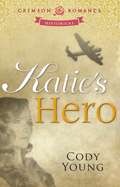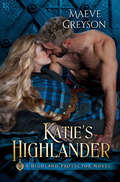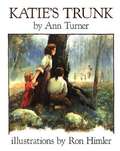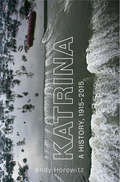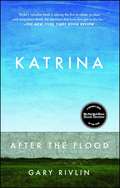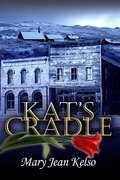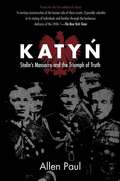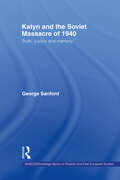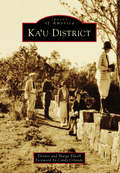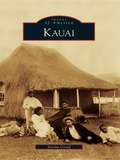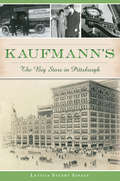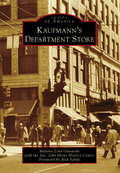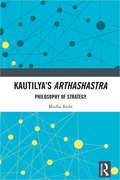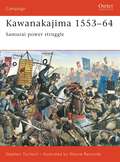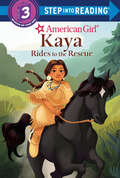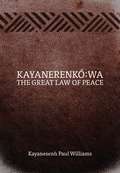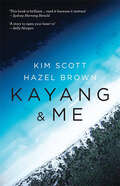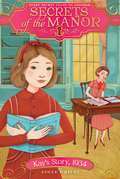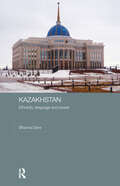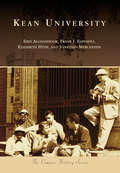- Table View
- List View
Katie Meets the Impressionists (Scholastic Bookshelf)
by James MayhewImagine if art could come to life! That's what happens when Katie steps into some of the world's greatest Impressionist paintings. And where Katie goes, adventure is never far behind!Katie discovers the true magic of Impressionist art in this addition to James Mayhew's Katie series!Katie and her grandmother are visiting the art museum. While admiring a painting of a beautiful garden, Katie is certain she can smell the flowers. Sure enough, when she opens her eyes, she is inside the painting! Join Katie as an ordinary day at the museum turns into a special gift for her grandmother's birthday.
Katie's Hero (Crimson Romance Ser.)
by Cody YoungLondon, 1940Katie&’s got a guilty secret and she&’s hiding out in London. Bombs are falling all around her, but she doesn&’t care if she lives or dies.Michael is a handsome young pilot who likes to play the hero, especially when there&’s a pretty girl involved. But duty calls him away, just when Katie needs him the most. Wounded and full of regrets, he&’s not sure she&’ll give him a second glance.Tom is a lovable rogue, or that&’s what he likes to think. He&’s touring the world at the Army&’s expense, but he&’s missing Katie more every day. Could he wrangle another chance with her - after everything he&’s done?Sensuality Level: Sensual
Katie's Highlander: A Highland Protector Novel (Highland Protectors #3)
by Maeve Greyson“Maeve Greyson knows how to create swoon-worthy heroes and sweet sexual tension. Ramsay MacDara stole my heart!”—Vonnie Davis, author of Highlander’s Beloved seriesAn archaeologist with a zest for life finds herself stranded in small-town North Carolina—with a brooding Highland hunk who’s straight out of ancient Scotland. Ramsay MacDara wishes the goddesses had left his arse back in the tenth century. That way he never would have met the gold digger who made a fool out of him. A loner at heart, Ramsay is riding his beloved horse through the woods near his family’s North Carolina theme park, Highland Life and Legends, when he hears tires squealing—followed by a thud—and rushes to the scene to help. That’s when he sets his eyes on a pair of long legs sticking out of the moon roof of a car. His interest piqued, the rest of her will soon arouse his greatest desires . . . and deepest fears. Archaeologist Katie Jenson is on a six-month sabbatical from her job at Princeton University. Following the death of her beloved father—whose dying request was for Katie to live life to the fullest—she’s headed to a friend’s beach house in North Carolina. But a momentary distraction takes her off the road and on the journey of her life . . . with a sex god in a kilt at her side. Ramsay’s passion is the stuff of legend—and it just may be Katie’s greatest discovery. Don’t miss any of Maeve Greyson’s enticing Scottish romances: The Highland Protector Series: SADIE’S HIGHLANDER | JOANNA’S HIGHLANDER | KATIE’S HIGHLANDER The Highland Hearts Series: MY HIGHLAND LOVER | MY HIGHLAND BRIDE | MY TEMPTING HIGHLANDER | MY SEDUCTIVE HIGHLANDER This ebook includes an excerpt from another Loveswept title.Praise for Katie’s Highlander“Outlander fans must get Katie’s Highlander! It’s a book you’ll never forget!”—Sharon Cullen, author of Lost to a Spy“I found myself unable to put Katie’s Highlander down once I was absorbed in it. I love a good time-travel romance—throw in a little bit of Scotland and Druids and I am in. I will be purchasing the other installments in this series as soon as possible.”—Romance Reviews Site
Katie's Trunk
by Ann Warren Turner Ronald HimlerKatie, whose family is not sympathetic to the rebel soldiers during the American Revolution, hides under the clothes in her mother's wedding trunk when they invade her home. Image Descriptions Present.
Katrina: A History, 1915–2015
by Andy HorowitzThe definitive history of Katrina: an epic of citymaking, revealing how engineers and oil executives, politicians and musicians, and neighbors black and white built New Orleans, then watched it sink under the weight of their competing ambitions. Hurricane Katrina made landfall in New Orleans on August 29, 2005, but the decisions that caused the disaster extend across the twentieth century. After the city weathered a major hurricane in 1915, its Sewerage and Water Board believed that developers could safely build housing away from the high ground near the Mississippi. And so New Orleans grew in lowlands that relied on significant government subsidies to stay dry. When the flawed levee system surrounding the city and its suburbs failed, these were the neighborhoods that were devastated. The homes that flooded belonged to Louisianans black and white, rich and poor. Katrina’s flood washed over the twentieth-century city. The flood line tells one important story about Katrina, but it is not the only story that matters. Andy Horowitz investigates the response to the flood, when policymakers reapportioned the challenges the water posed, making it easier for white New Orleanians to return home than it was for African Americans. And he explores how the profits and liabilities created by Louisiana’s oil industry have been distributed unevenly among the state’s citizens for a century, prompting both dreams of abundance—and a catastrophic land loss crisis that continues today. Laying bare the relationship between structural inequality and physical infrastructure—a relationship that has shaped all American cities—Katrina offers a chilling glimpse of the future disasters we are already creating.
Katrina
by Gary RivlinTen years after Hurricane Katrina made landfall in southeast Louisiana--on August 29, 2005--journalist Gary Rivlin traces the storm's immediate damage, the city of New Orleans's efforts to rebuild itself, and the storm's lasting affects not just on the city's geography and infrastructure--but on the psychic, racial, and social fabric of one of this nation's great cities.Much of New Orleans still sat under water the first time Gary Rivlin glimpsed the city after Hurricane Katrina. Then a staff reporter for The New York Times, he was heading into the city to survey the damage. The Interstate was eerily empty. Soldiers in uniform and armed with assault rifles stopped him. Water reached the eaves of houses for as far as the eye could see. Four out of every five houses--eighty percent of the city's housing stock--had been flooded. Around that same proportion of schools and businesses were wrecked. The weight of all that water on the streets cracked gas and water and sewer pipes all around town and the deluge had drowned almost every power substation and rendered unusable most of the city's water and sewer system. People living in flooded areas of the city could not be expected to pay their property taxes for the foreseeable future. Nor would all those boarded-up businesses--21,000 of the city's 22,000 businesses were still shuttered six months after the storm--be contributing their share of sales taxes and other fees to the city's coffers. Six weeks after the storm, the city laid off half its workforce--precisely when so many people were turning to its government for help. Meanwhile, cynics both in and out of the Beltway were questioning the use of taxpayer dollars to rebuild a city that sat mostly below sea level. How could the city possibly come back? This book traces the stories of New Orleanians of all stripes--politicians and business owners, teachers and bus drivers, poor and wealthy, black and white--as they confront the aftermath of one of the great tragedies of our age and reconstruct, change, and in some cases abandon a city that's the soul of this nation.
Kat's Cradle
by Mary Jean KelsoKatrina (Kat) Sturdivant's young life has been a struggle to survive under harsh conditions in a dangerous mining town during the "Bad Man of Bodie" days. She has lost her mother and baby brother and, now, her father has been killed. She is convinced his death was not an accident and sets out to find his killer. Kat, the pursuer, soon becomes the pursued.
Katyn: Stalin’s Massacre and the Triumph of Truth
by Allen PaulTwenty years ago, Allen Paul wrote the first post-communist account of one of the greatest but least-known tragedies of the 20th century: StalinÆs annihilation of PolandÆs officer corps and massive deportation of so-called \u201cbourgeoisie elements\u201d to Siberia. Today, these brutal events are symbolized by one word, Katyn—a crime that still bitterly divides Poles and Russians. PaulÆs richly updated account covers Russian attempts to recant their admission of guilt for the murders in Katyn Forest and includes recently translated documents from Russian military archives, eyewitness accounts of two perpetrators, and secret official minutes published here for the first time that confirm that U.S. government cover-up of the crime continued long after the war ended.PaulÆs masterful narrative recreates what daily life was like for three Polish families amid momentous events of World War II—from the treacherous Nazi-Soviet invasion in 1939 to a rigged election in 1947 that sealed PolandÆs doom. The patriarch of each family was among the Polish officers personally ordered by Stalin to be shot. One of the families suffered daily repression under the German General Government. Like thousands of other Poles, two of the families were deported to Siberia, where they nearly died from forced labor, starvation, and neglect. Through painstaking research, the author reconstructs the lives of these families including such stories as a miraculous escape on the last transport of Poles leaving Russia and a motherÆs daring ski trek over the Carpathian Mountains to rescue a daughter she had not seen in six years. At the heart of the drama is the PolesÆ uncommon belief in \u201cvictory in defeat\u201d—that their struggles made them strong and that freedom and independence, inevitably, would be regained.
Katyn and the Soviet Massacre of 1940: Truth, Justice and Memory (BASEES/Routledge Series on Russian and East European Studies #Vol. 20)
by George SanfordThe Soviet massacre of Polish prisoners of war at Katyn and in other camps in 1940 was one of the most notorious incidents of the Second World War. The truth about the massacres was long suppressed, both by the Soviet Union, and also by the United States and Britain who wished to hold together their wartime alliance with the Soviet Union. This informative book examines the details of this often overlooked event, shedding light on what took place especially in relation to the massacres at locations other than Katyn itself. It discusses how the truth about the killings was hidden, how it gradually came to light and why the memory of the massacres has long affected Polish-Russian relations.
Ka'u District
by Marge Elwell Cindy Orlando Dennis ElwellKa'u is the largest district in Hawai'i and the southernmost. Historically, it is important as the most likely landing area for the first Hawaiians and the location of the first settlement. It was the location of some of the last battles for control of Hawai'i island, and the decision of Ka'u's last ali'i, Keoua Ku'ahu'ula, to agree to a meeting with Kamehameha, which he believed would lead to his death, was a crucial event in the creation of a unified Hawaiian kingdom. After Western contact, the sugar industry dominated the economy of Ka'u, and ranching was also important. Although the sugar industry closed in 1996, the rural character has been maintained, and Ka'u now enjoys some of the longest stretches of undeveloped highway and coastline in the state. The appeal of the district's natural beauty owes much to the Kilauea and Mauna Loa volcanoes, and Ka'u has a unique location between the two segments of Hawai'i Volcanoes National Park.
Kauai: 100 Years In Postcards (Images of America)
by Stormy CozadCapt. James Cook stood on his ship gazing at the coastline of Kauai and the Hawaiian village of Waimea in 1778. Kauai was its own kingdom then, and King Kaumualii--the king of Kauai who challenged Kamehameha and managed to keep Kauai from being conquered by him--would not be born for two more years. The oldest and northernmost of the main Hawaiian Islands, Kauai did not see well-meaning missionaries until 1820. From the moment Cook put Kauai on the map, it has gathered admirers from all over the world who come to experience its exquisite beauty and wonder. Fortunately, many photographers have had their own love affairs with Kauai, leaving a vast amount of documentation.
Kaufmann's: The Big Store in Pittsburgh (Landmarks)
by Letitia Stuart SavageIn 1871, Jacob and Isaac Kaufmann created a classic Pittsburgh institution. The business grew from a small store on the South Side to a mammoth clothing house downtown that outfitted the community. The removal of the original freestanding clock upset customers, so Kaufmann's added its iconic version in 1913. A redesign of the store's first floor attracted national attention in the 1930s. While most Pittsburghers remember and celebrate the downtown store, others recall the suburban branches--miniatures of the expansive flagship store. Join Letitia Stuart Savage on a journey to a time of leisurely shopping for the latest fashions complete with a side of Mile High Ice Cream Pie from the Tic Toc Restaurant.
Kaufmann's Department Store (Images of America)
by Melanie Linn Gutowski The Senator John Heinz History Center Rick SebakKaufmann's Department Store was a force in Pittsburgh retail from its humble beginnings in 1871 until its merger with Federated Department Stores in 2006. The "Big Store" downtown was a landmark shopping emporium with 12 floors of everything from cosmetics and groceries to wedding gowns and lawn mowers. Under the leadership of Edgar J. Kaufmann and his wife, Liliane, the store became a forum for exhibitions of art, cutting-edge technology, and Parisian haute couture. Generations of Pittsburghers hold fond memories of meeting friends and family under the famous Kaufmann's clock to lunch at the Tic Toc Restaurant, pick up cookies at the Arcade Bakery, or peer into the store's enchanting Christmas window displays each December.
Kautilya's Arthashastra: Philosophy of Strategy
by Medha BishtThis book examines in detail the strategic relevance of the Arthashastra. Attributed to the fourth century B.C., this classical treatise on state and statecraft rests at the intersection of political theory and international relations. Adopting a hermeneutic approach, the book discusses certain homologies related to concepts such as power, order, and morality. Underlining the conceptual value of the Arthashastra and classical texts such as Hitopdesha and Pancatantra, this volume highlights the non-western perspectives related to diplomacy and statecraft. It shows how a comparative analysis of these texts reveals a continuity rather than a change in the styles, tactics, and political strategies. The book also showcases the value these ancient texts can bring to the study of contemporary international relations and political theory. This volume will be of interest to students, scholars and teachers of political studies, Indian political thought, and philosophy, South Asian studies, political theory and international relations.
Kavichakravarthy Kambar
by Mahavidwan Ra Raghava IyengarKambar, a 12th centuary poet lived during the regime of King Rakendra Chola. In addition to the Ramayanam, Kambar has also authored other works like the Saraswathi Andathi and Kangai Puranam
Kawanakajima 1553-64
by Wayne Reynolds Stephen TurnbullKawanakajima is unique in history. In the space of 12 years, between 1553 and 1564, this valley deep in the mountains of central Japan witnessed no fewer than five battles between two of Japan's greatest warlords. Takeda Shingen and Uesugi Kenshin were both descended from great families and were highly skilled tacticians. Both had taken the tonsure and risen to high rank in their respective Buddhist sects. When Shingen attempted to seize control of Shinano province they were set on a collision course. Stephen Turnbull chronicles the see-saw struggle between two men who epitomize the warrior daimyo from Japan's 'Warring States' period.
Kaya Rides to the Rescue (Step into Reading)
by Emma Carlson BerneAmerican Girl® Kaya™ and her horse go on an adventure in this Step 3 Step into Reading leveled reader that takes place in pre-colonial America—and includes a bonus pull-out poster!Kaya is a Nez Perce girl who takes pride in helping out and supporting the tribe—and also in her beloved horse, Steps High. But when she chooses racing her horse over family responsibilities, Kaya has to prove herself to earn her tribe&’s respect. Kaya&’s story of adventure in the wilderness is sure to engage today's readers as they learn what it was like to be a Native American girl in 1764 in this Step 3 Step into Reading leveled reader. Great for American Girl fans ages 5 to 8, this storybook includes a pull-out poster! This exciting Step into Reading is based on an American Girl story by Janet Shaw. Step 3 readers feature engaging characters in easy-to-follow plots about popular topics for children who are ready to read on their own. Introduced in 1986, American Girl&’s flagship line of historical characters features 18-inch dolls, books, and accessories that give girls a dramatic understanding of the role women and girls played in shaping our country. Look out for these other great books: • Samantha Helps a Friend (American Girl) 9780593381878 • Freedom for Addy (American Girl) 9780593381915 • Molly&’s Christmas Surprise (American Girl) 9780593381960
Kayanerenkó: The Great Law of Peace
by Kayanesenh Paul WilliamsSeveral centuries ago, the five nations that would become the Haudenosaunee — Mohawk, Oneida, Onondaga, Cayuga, and Seneca — were locked in generations-long cycles of bloodshed. When they established Kayanerenkó:wa, the Great Law of Peace, they not only resolved intractable coinflicts, but also shaped a system of law and government that would maintain peace for generations to come. This law remains in place today in Haudenosaunee communities: an Indigenous legal system, distinctive, complex, and principled. It is not only a survivor, but a viable alternative to Euro-American systems of law. With its emphasis on lasting relationships, respect for the natural world, building consensus, and on making and maintaining peace, it stands in contrast to legal systems based on property, resource exploitation, and majority rule. Although Kayanerenkó:wa has been studied by anthropologists, linguists, and historians, it has not been the subject of legal scholarship. There are few texts to which judges, lawyers, researchers, or academics may refer for any understanding of specific Indigenous legal systems. Following the United Nations Declaration on the Rights of Indigenous Peoples, and a growing emphasis on reconciliation, Indigenous legal systems are increasingly relevant to the evolution of law and society. In Kayanerenkó:wa Great Law of Peace Kayanesenh Paul Williams, counsel to Indigenous nations for forty years, with a law practice based in the Grand River Territory of the Six Nations, brings the sum of his experience and expertise to this analysis of Kayanerenkó:wa as a living, principled legal system. In doing so, he puts a powerful tool in the hands of Indigenous and settler communities.
Kayang & Me
by Kim Scott Hazel BrownA monumental family history of Australia's Wilomin Noongar people, this is a powerful story of community and belonging. Revealing the deep and enduring connections between family, country, culture, and history that lie at the heart of indigenous identity, this book—a mix of storytelling and biography—offers insight into a fascinating community.
Kayiru Part-I
by Thakazhi Sivasankara Pillai C. A. BalanThe novel stretches across 7 generations and a time span of 150 years vividly portraying the culture, tradition and the social order of yesteryears’ Kerala and the gradual transition it went through to arrive at the current state of affairs. With multitude of characters it recounts the social, political, economic reformations and upheavals the society, families and individuals went through those times.
Kayiru Part-II
by Thakazhi Sivasankara Pillai C. A. BalanThe novel stretches across 7 generations and a time span of 150 years vividly portraying the culture, tradition and the social order of yesteryears’ Kerala and the gradual transition it went through to arrive at the current state of affairs. With multitude of characters it recounts the social, political, economic reformations and upheavals the society, families and individuals went through those times.
Kayiru Part-III
by Thakazhi Sivasankara Pillai C. A. BalanThe novel stretches across 7 generations and a time span of 150 years vividly portraying the culture, tradition and the social order of yesteryears’ Kerala and the gradual transition it went through to arrive at the current state of affairs. With multitude of characters it recounts the social, political, economic reformations and upheavals the society, families and individuals went through those times.
Kay's Story, 1934
by Adele WhitbyIn this stunning conclusion to the Chatswood family's story, the first story arc of the Secrets of the Manor series, a mysterious benefactor helps the Vandermeers during the Great Depression--and readers finally discover the family's biggest secret!The Great Depression is raging across America and even the Vandermeers have fallen on hard times. In an attempt to stay afloat, Kay and her parents have started living in the guest cottage and getting Vandermeer Manor ready for renters. Money starts coming in when a mysterious man purchases some family heirlooms, but questions are raised when it comes to light that the wealthy benefactor has knowingly paid more money for the heirlooms than they are actually worth. Who is he, why does he want to help the Vandermeers, and what does he want in return? In this sixth installment of Secrets of the Manor, the biggest family secret will finally be revealed--a secret that's been hidden away for eighty years. Have you followed the trail of clues that were sprinkled throughout the first five books? Discover the truth in this thrilling conclusion to the first arc of this fascinating historical fiction series! And don't miss the next books in the Secrets of the Manor series coming in Summer 2015--featuring a new family with its own set of intriguing secrets!
Kazakhstan - Ethnicity, Language and Power: Ethnicity, Language And Power (Central Asian Studies)
by Bhavna DaveKazakhstan is emerging as the most dynamic economic and political actor in Central Asia. It is the second largest country of the former Soviet Union, after the Russian Federation, and has rich natural resources, particularly oil, which is being exploited through massive US investment. Kazakhstan has an impressive record of economic growth under the leadership of President Nursultan Nazarbaev, and has ambitions to project itself as a modern, wealthy civic state, with a developed market economy. At the same time, Kazakhstan is one of the most ethnically diverse countries in the region, with very substantial non-Kazakh and non-Muslim minorities. Its political regime has used elements of political clientelism and neo-traditional practices to bolster its rule. Drawing from extensive ethnographic research, interviews, and archival materials this book traces the development of national identity and statehood in Kazakhstan, focusing in particular on the attempts to build a national state. It argues that Russification and Sovietization were not simply 'top-down' processes, that they provide considerable scope for local initiatives, and that Soviet ethnically-based affirmative action policies have had a lasting impact on ethnic élite formation and the rise of a distinct brand of national consciousness.
Kean University (Campus History)
by Frank J. Esposito Elizabeth Hyde Erin Alghandoor Jonathan MercantiniKean University, New Jersey's third largest institution of higher education, has a fascinating history dating back to its 1855 founding in Newark. Initially a normal school used for training the city's teachers, it has evolved into a university that offers outstanding undergraduate and graduate programs in many fields, including medical and allied health, management, speech, fine arts, liberal arts, architecture, and psychology. Teacher education programs at Kean result in the university graduating the highest number of teachers in the state. Kean also offers doctoral degrees in several areas, including educational leadership (EdD), school and clinical psychology (PsyD), physical therapy (PhD), and nursing (PhD). This photographic history features striking images from the university's archives, which span from the late 19th century to the present. Of special interest are the descriptions of the campus moving from Newark to Union and the creation of new campus sites in Ocean County, New Jersey, and Wenzhou, China.

